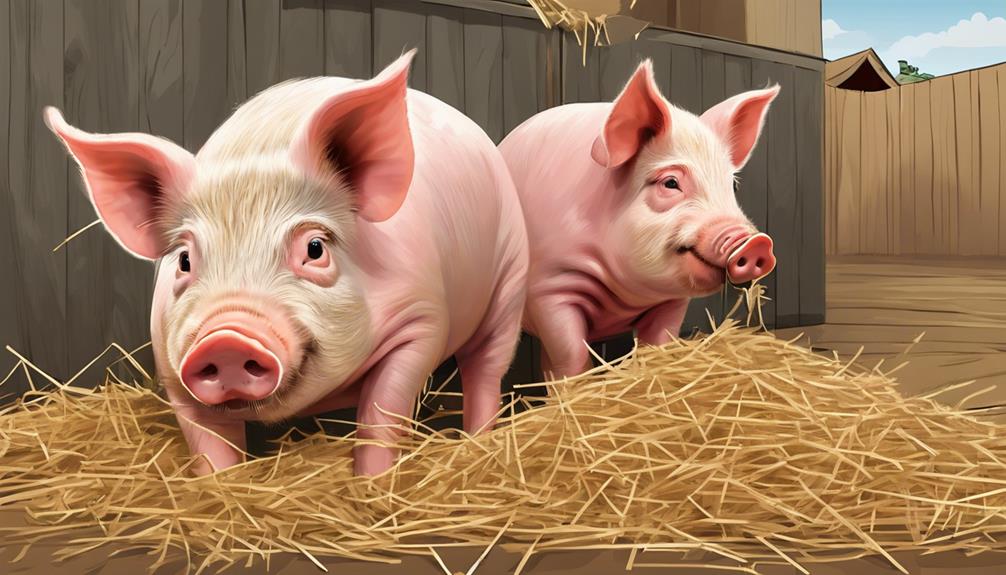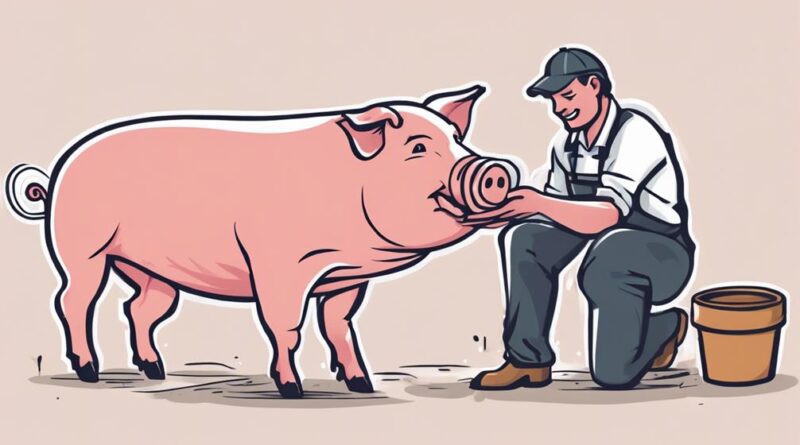Effective Pig Training Techniques and Behavioral Insights
Pig training prowess begins with patience and precision. Ever wondered how to hone your skills and understand these intelligent creatures better?
Uncover practical strategies to enhance your pig training repertoire, from positive reinforcement methods to tackling challenging behaviors. Stay tuned to discover how you can form a harmonious bond with your porcine companions through effective training techniques and valuable behavioral insights.
Understanding Pig Behavior
To effectively train pigs, understanding their behavior is crucial. Pig communication is primarily non-verbal, relying on vocalizations, body language, and even scent signals. Pigs use different vocalizations such as grunts, squeals, and oinks to express various emotions like excitement, distress, or contentment. By recognizing these vocal cues, you can better understand your pig's state of mind and respond accordingly during training sessions.
Feeding behaviors also play a significant role in pig training. Pigs are naturally foragers, rooting around for food in the soil. This behavior can be harnessed during training by using food as a positive reinforcement tool. When teaching new commands or tricks, utilizing food rewards can motivate pigs to learn quickly and effectively. You can observe feeding behaviors to gauge your pig's interest and use this to your advantage in training sessions.
Understanding pig behavior isn't only about interpreting their communication signals but also about recognizing their natural instincts and tendencies. By acknowledging how pigs communicate and how feeding behaviors influence their actions, you can tailor your training methods to suit their needs and facilitate successful learning experiences. With this knowledge as your foundation, you can build a strong bond with your pig and achieve training goals more efficiently.
Positive Reinforcement Techniques
Positive reinforcement techniques are essential for effectively training pigs. Behavior modification methods that focus on reward-based training have been proven to be highly successful in shaping behaviors in pigs. By utilizing operant conditioning strategies, you can encourage desirable behaviors and discourage unwanted ones in your pigs.
When implementing positive reinforcement techniques, it's crucial to use rewards that are highly motivating for the pigs. This could include food treats, verbal praise, or even physical affection, depending on what the pig responds to best. By consistently rewarding the pig for displaying the desired behavior, you're reinforcing that action and increasing the likelihood of it being repeated in the future.
One effective method is shaping behaviors through successive approximations. This involves breaking down the desired behavior into small achievable steps and rewarding the pig for each step towards the final behavior. This gradual approach helps the pig understand what's expected of them and allows for steady progress towards the ultimate goal.
Clicker Training Basics
When training pigs, incorporating clicker training basics can further enhance your positive reinforcement techniques. Clicker training is a popular method that utilizes a small handheld device that makes a clicking sound when pressed to mark the desired behavior in pigs. Here are some key points to keep in mind when incorporating clicker training into your pig training routine:
- Clear Communication: Clicker training helps in establishing clear communication with your pig. The distinct sound of the clicker marks the exact moment the pig performs the desired behavior, making it easier for them to understand what they're being rewarded for.
- Consistent Reinforcement: By using the clicker to mark the behavior you want to reinforce, you can consistently reward your pig for their actions. This helps in shaping behavior effectively as the pig learns to associate the click with a positive outcome.
- Shaping Behavior: Clicker training allows you to shape complex behaviors by breaking them down into smaller achievable steps. You can click and treat each small progression towards the desired behavior, gradually guiding your pig to perform the complete behavior.
- Positive Association: The clicker becomes a signal for the pig that a reward is coming, creating a positive association with the training process. This encourages the pig to actively participate and engage in the training sessions.
Target Training for Pigs
Implement target training as a fundamental technique in your pig training regimen to enhance their learning and behavior shaping abilities. Target training involves teaching pigs to touch a designated object, such as a stick or disc, with their nose or another body part on cue.
To start target training, introduce the target object to your pig. Use food rewards to encourage them to interact with the target. When your pig touches the target, immediately reward them with a treat. Repeat this process consistently, associating the action with the reward. Over time, your pig will learn to touch the target upon command.
Food rewards play a crucial role in target training. Pigs are highly food-motivated animals, making treats an effective training tool. Choose small, tasty treats that your pig enjoys to reinforce their positive behavior during target training sessions. Consistency in rewarding correct responses will help solidify the desired behavior.
Target training requires a time commitment from you. Dedicate regular short training sessions to work with your pig on target training. Keep the sessions engaging and end them on a positive note to maintain your pig's interest and motivation. By investing time and effort into target training, you can effectively shape your pig's behaviors and improve their responsiveness to commands.
Socialization Strategies for Pigs
To effectively socialize your pigs, regularly expose them to different environments and introduce them to various animals and people. This is crucial for their development and overall well-being. Here are some key strategies to help you socialize your pigs effectively:
- Playmate introductions: Introduce your pigs to other pigs or animals of similar size in a controlled environment. This helps them learn social cues and develop important social skills.
- Group socialization: Allow your pigs to interact with other pigs in a group setting. This promotes healthy social behaviors and helps them understand hierarchy within the group.
- Age-appropriate interactions: When socializing your pigs, ensure that the interactions are suitable for their age and size. Young pigs may need gentler introductions compared to older ones.
- Handling techniques: Practice proper handling techniques when socializing your pigs. This includes gently petting them, offering treats as positive reinforcement, and avoiding sudden movements that may startle them.
Addressing Aggression in Pigs
Addressing aggression in pigs is crucial for their well-being and the safety of those around them. Aggression in pigs is often rooted in fear, dominance, or territorial instincts. Behavior modification strategies can help mitigate these tendencies. One effective method is setting clear boundaries in their environment and using positive reinforcement techniques to encourage appropriate behavior. Establishing routine rules and expectations can reduce stress and prevent aggression. Consistently reinforcing positive behaviors and redirecting negative ones is key to reshaping their responses. Patience and persistence are necessary, as behavior change takes time. By addressing underlying issues through behavior modification, long-term success in managing pig behavior can be achieved.
Enrichment Activities for Pigs

When considering enrichment activities for pigs, focus on providing stimulating and engaging experiences that cater to their natural behaviors and intelligence. Pigs are intelligent animals that thrive when given opportunities to explore, problem-solve, and engage their senses. To keep your pigs mentally and physically active, consider the following enrichment activities:
- Foraging Challenges: Hide treats or their food in different areas of their enclosure to encourage natural rooting behavior and provide mental stimulation.
- Novel Objects: Introduce new objects like balls, ropes, or puzzle feeders to pique their curiosity and encourage exploration.
- Sensory Stations: Set up stations with different textures, scents, and sounds to engage their senses and keep them entertained.
- Interactive Toys: Offer toys that dispense treats when manipulated, promoting cognitive challenges and keeping them engaged.
Advanced Training Approaches
Consider incorporating more complex commands and behaviors into your pig training regimen to elevate their skills and mental acuity. By delving into advanced training approaches, you can further enhance your pig's capabilities through behavioral modification techniques and cognitive training exercises.
Behavioral modification plays a crucial role in refining your pig's responses to various cues and commands. Introduce challenges that require your pig to exhibit specific behaviors in response to different stimuli. For example, you could work on teaching your pig to differentiate between various objects or to follow a sequence of commands in a specific order. These tasks not only stimulate your pig's cognitive abilities but also strengthen the bond between you and your pet.
Cognitive training is another valuable tool in advancing your pig's skill set. Engage your pig in activities that encourage problem-solving and critical thinking. For instance, you could hide treats around their environment and guide them to use their sense of smell to locate the hidden rewards. Additionally, consider teaching your pig more complex tricks that require them to understand and execute multi-step processes.
Frequently Asked Questions
Can Pigs Be Trained to Do Tricks or Perform in Shows?
Yes, you can train pigs to do tricks and perform in shows. Pig agility and showmanship are key aspects of their training. With dedication and patience, trick training can turn into a captivating performance art.
Pigs are intelligent animals that can learn various tricks and behaviors with the right training approach. By incorporating positive reinforcement and consistent practice, you can showcase the impressive abilities of pigs in shows and events.
What Are Some Common Health Issues That May Affect a Pig's Training Progress?
When training pigs, it's essential to watch out for common health issues that could impact their progress. Nutrition requirements play a key role in their well-being, so providing a balanced diet is crucial.
Additionally, keeping an eye on parasite control is vital to ensure your pig stays healthy and focused during training sessions. By addressing these health concerns, you can set your pig up for success in its training journey.
How Can You Prevent Pigs From Developing Destructive Behaviors Like Excessive Rooting or Chewing?
To prevent pigs from developing destructive behaviors like excessive rooting or chewing, try using rooting prevention techniques and providing enrichment strategies.
For chewing management, offer appropriate distractions to keep them engaged and occupied.
By implementing these strategies, you can help redirect their natural behaviors in a positive way and prevent destructive habits from forming.
Are There Any Specific Training Techniques for Working With Piglets Versus Adult Pigs?
When training piglets versus adult pigs, consider their different stages of development. Piglets benefit from gentle socialization techniques that aid in cognitive development. Handle their fear responses with care and use positive reinforcement techniques to encourage desired behaviors.
Adult pigs may require more patience and consistency in training due to established habits. Tailor your training approach to suit the age and maturity level of the pigs you're working with to achieve best results.
How Do You Handle a Pig That Is Consistently Unresponsive or Stubborn During Training Sessions?
When dealing with a pig that's unresponsive or stubborn in training, patience and consistency are key. Stay calm and use positive reinforcement to encourage desired behaviors.
If the pig isn't cooperating, try redirecting its attention and focus back on the task at hand. Remember that pigs, like any animal, may have off days, so be patient and persistent in your training efforts.
With time and effort, you can help the pig improve its responsiveness.
Conclusion
In conclusion, effective pig training techniques involve understanding pig behavior, using positive reinforcement, clicker training, target training, socialization strategies, addressing aggression, and providing enrichment activities.
By incorporating these methods into your pig training regimen, you can build a strong bond with your pig and help them learn new behaviors and skills.
Remember to be patient, consistent, and always prioritize the well-being and happiness of your pig throughout the training process.
Happy training!
